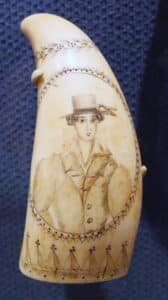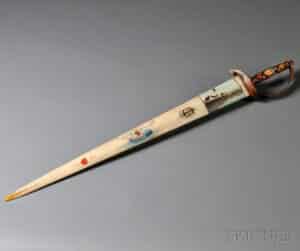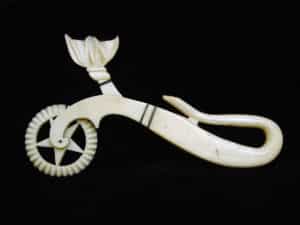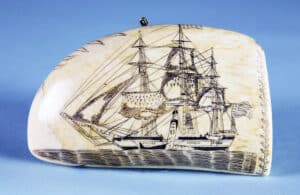by Kary Pardy

accompanied them on voyages and produced a fair amount of scrimshaw. Notably, Sallie Smith, the wife of Captain Frederick Howland Smith, created pieces that are just as highly regarded, if not more so, then those of her male counterparts. Scrimshaw by an unknown artist, ca. 1830-1860
courtesy of the Brooklyn Museum

If you’re a nautical fanatic, a coast dweller, or a fan of early American arts, you probably know and appreciate scrimshaw. But what is it really, and how do you know you’re looking at the real deal? If you find it, how do you keep it shipshape for years to come? We’re here to help.
Scrimshaw is a broad term that covers art carved or engraved into the teeth, bones, or other hard parts of ocean creatures. Native tribes used it for ritualistic practices and artists have pushed the boundaries of the term in the modern age, but we will use it more narrowly for the purposes of this article to describe the bone/ivory based seacrafts of sailors, and particularly, whalers.
Making Scrimshaw
A common theory is that the term scrimshaw originated to describe men on whaling ships using whatever they had on hand in ready supply (whale parts) to make tools for the ship. It later broadened to refer to crafts sailors made in their free time for fun or to bring as trinkets to those back home. From the carved plaques of Nantucket baskets to pins, women’s corset busks, hinges, latches, pie crimpers, handles for tools or canes, or woodwork with inlays, scrimshaw pops up on the market in many forms, but none is so famous as the iconic carved sperm whale tooth.
Scrimshaw teeth were so prevalent because they presented an ideal medium. They were readily available if the hunt had gone well and were not used for any other commercial purpose. Teeth had uniform surfaces, could be polished into a pleasing sheen and held pigment well. Walrus ivory had similar characteristics, with added length to craft larger projects such as swifts. If sailors caught other varieties of whales, they used the baleen plates from the whale’s mouth to work upon, though the fragility of these pieces made them less desirable, except to make flexible items like corset stays or umbrella ribs.
Whatever hard material one selected needed to first be prepped to remove any natural inconsistencies or bumps. Artists scraped their surfaces with a knife and then relied on rough sharkskin to sand them. The carving or engraving itself was done with sailing needles or knives, and one’s skill and the rocking and rolling of the ship produced a variety of different quality images. That said, whalemen were skilled tradesmen, and the dexterity needed in their day jobs transferred over to their crafts to create some beautiful pieces. Sailors carved what they knew and what would please those at home. You’ll see lots of ships, sea imagery, shoreline imagery, loved ones, and nautical symbols.
To really make these carvings pop, scrimshanders periodically filled their work in with black and sometimes colored pigments and used what they had on hand: lampblack (a suspension of carbon in oil in oil lamps of the whaling tryworks), soot, gunpowder, and oil, or commercially-produced ink. Colored pigments also came from purchased ink, or from homemade fruit and vegetable dyes and verdigris, the green oxidation you’ll see on copper and brass when they corrode.
Is it real?

such as this decorative 19th century pie crimper.
photo: New Bedford Whaling Museum
As with most antiques, the more you know about the materials and methods used in their making, the easier it is to spot a fake. The first step is to determine if you are working with organic material or plastic. One method is to use pliers to heat a very thin pin or needle and attempt to stick it into your item in an inconspicuous spot. If the piece in question melts, you’re looking at plastic. Real bone or ivory will show only a small black dot.
Blacklight also offers a less invasive test. Plastic will either show no color change under a blacklight, or it will give off a dull blue, whereas bone or ivory items will appear white or have a yellowish cast, no matter their color in standard light.
Tricky forgers sometimes try to pass bone off as teeth/ivory, such as those who adhere two sections of cow bone together to create a tooth. Always watch out for seam lines. If seams aren’t visible, curious collectors should also check the base of their piece and look for the natural properties of a tooth cavity and a rough edge as opposed to a clean-cut edge and smooth interior. Closer inspection under a loop or microscope can also distinguish a tooth or a tusk from bone.
Keeping Scrimshaw Safe

in the “cutting in” process. photo: Osana Auctions, Nantucket
Once you’ve found a piece you love and have added it to your collection, now what? Preservationists agree that you should keep your scrimshaw out of direct sunlight. Too much light will dry out your piece and may result in cracks. It can also cause the pigments to fade. Handle it with freshly-washed hands or cotton gloves to prevent the oils from your hands from staining the surface (you may have seen this happen with older ivory piano keys). Also, avoid places with changing temperatures and levels of humidity – consistency is key.
Some owners choose to wax their pieces once or twice a year for preservation, and a warm beeswax or Renaissance Wax is recommended. Waxing scrimshaw gives it a nice sheen and keeps it protected.
If you need to clean your piece, do not use water. The ivory might swell or crack, and pigments could be washed away or permanently damaged. Similarly, soap and other cleaning solutions could even eat away at some of the finely carved lines. Dirt and oils are best removed with a light dusting or a gentle wipe with a clean cotton cloth. If any residue remains, dab it with a cotton swab soaked in rubbing alcohol, but do not scrub. Doing so might remove pigments or wear away at the engraved lines so that they will not hold ink. If this still isn’t enough, consider taking your piece to a professional restorer or scrimshander.
Wherever and however you store it, make sure you can see your scrimshaw. Much like fine jewelry (even down to the high price points), these are items to be treasured and passed on, enjoyed for their connection to America’s craftsmen sailors and life on the New England coast.





Related posts: